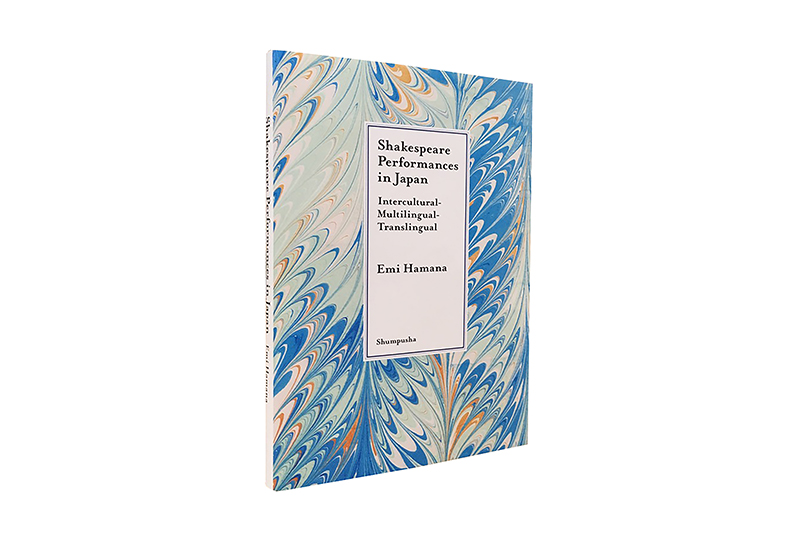
Shakespeare Performances in Japan
Intercultural-Multilingual-Translingual
- Emi HAMANA / 2019.9
- JPY 5,500 / A4 size, softcover, 188 pages
- bookdesign: Toshinobu NAGATA
This book is the result of three research projects: the Intercultural Performances of Shakespeare’s Plays, Intercultural Education through World Shakespeare Performances and Translingual Performances of Shakespeare Worldwide. Although these projects were closely related and built upon one another, this book is divided into two parts—Part I: Intercultural and Multilingual Performance and Part II: Translingual Performance—according to the order of their development, logical continuity and coherence. The outcomes of the critical explorations presented in Part I lead to the proposal of a challenging new field in Part II, set against the backdrop of a paradigm shift in language education and new approaches in theatre studies.
(ISBN 9784861106576)
Table of contents
Acknowledgements
Introduction
Part I Intercultural and Multilingual Performance
Chapter 1 This Is, and Is Not, Shakespeare: A Japanese–Korean Transformation of Othello
1. The Critical Impact of Local Shakespeare on Global Shakespeare: Othello in the Japanese Mugen Noh Style with Elements of Korean Shamanism: A Creative Subversion
2. The Critical Impact of the Japanese–Korean Adaptation of Othello on Global Shakespeare
Chapter 2 Performing Shakespeare after the 11 March 2011 Disaster: Yamanote Jijosha’s The Tempest
1. The Tempest as Prospero’s Apocalyptic Delusion
2. Caliban’s Binding and Torture on Stage
3. An Additional Japanese Ending
Chapter 3 The Last Shakespeare Plays Directed by Yukio Ninagawa: Possessed by the Power of Theatre
1. Richard II with Wheelchairs and the Tango
2. NINAGAWA (or Samurai) Macbeth: The Legendary Production Revived
3. The Two Gentlemen of Verona with an All-Male Cast
Chapter 4 Multilingual Performances of Shakespeare Worldwide: Multilingual King Lear, Directed by Tadashi Suzuki
1. Tadashi Suzuki and Multilingual Performance
2. A Short Performance History of King Lear (1984–2006), Directed by Tadashi Suzuki
3. The Four-Language Performance of King Lear (2009)
Part II Translingual Performance
Chapter 5 Translingual Performances of Shakespeare Worldwide with a Focus on Henry V
1. Fundamental Concepts and Facts
2. An Analysis of Henry V, Act 5, Scene 2
Chapter 6 Lear Dreaming, Directed by Ong Keng Sen
1. Basic Ideas of Lear Dreaming
2. An Analysis of Several Scenes in Lear Dreaming from a Translingual Perspective
Chapter 7 Safaring the Night: A Midsummer Night’s Dream Updated
1. Basic Information about Safaring the Night
2. An Analysis of Several Elements of Safaring the Night from a Translingual Perspective
Conclusion
Appendix: Performance Review: Sandaime Richard, written by Hideki Noda and directed by Ong Keng Sen. Performed in Japanese, English and Indonesian, with Japanese and English Subtitles.
Notes
Works Cited
List of Original Publications
Author Profile
Index
Author
Emi HAMANA
PhD, Professor Emeritus of Tsukuba University, is currently Professor of English Literature at Tokyo Woman’s Christian University. She specialises in Shakespeare studies, cultural studies and English education, focusing on multicultural, multilingual and translingual performances of Shakespeare’s plays worldwide, along with intercultural collaboration in contemporary theatre. Her current research interest concerns cognitive and digital approaches to Shakespeare. Her publications include The Wonder of Gender: Shakespeare and Gender (in Japanese; Nihon Tosho Centre, 2004) and Connecting Cultures: From Shakespeare to Contemporary Asian Theatre (in Japanese; Tsukuba UP, 2012). She has also contributed to The Cambridge Guide to the Worlds of Shakespeare, vol. 2 (Cambridge UP, 2016) and Shakespeare; His Infinite Variety (Lodz UP, 2017; to be re-published by Columbia UP, 2019), and to many academic journals. Her website is at https://emihamana.net.
Order this book
